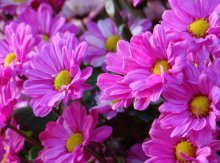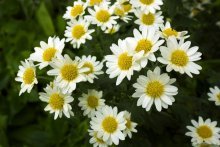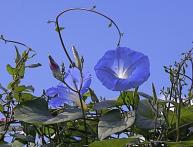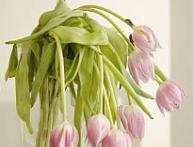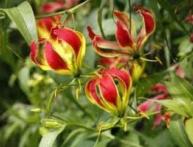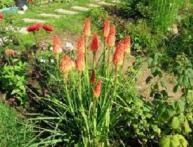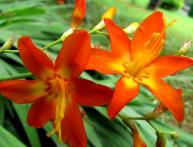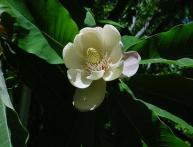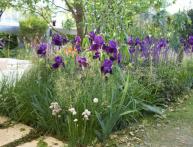Chamomile chrysanthemum: description of the type and rules of cultivation

The main purpose of the chamomile chrysanthemum is to decorate gardens and premises. Initially chrysanthemum It was grown in Asian countries as indoor plants, and at the end of the 18th millennium it was brought to Europe.
Content:
- Description of chrysanthemum chamomile
- Advantages and features of the flower
- Features of growing chrysanthemums
- Benefits and applications in cooking and traditional medicine
Description of chrysanthemum chamomile
Chamomile chrysanthemum (Esenna) is a perennial shrub plant. It has flower heads that resemble a daisy. Inflorescences are collected in umbrellas. Outdoors, flowering begins in September and continues until cold weather. Flowers are cut and used to decorate the interior of the house. Chamomile chrysanthemums reach a height of up to 1.5 m.
The leaves are 4 -12 cm long and 4 - 6 cm wide with coarsely toothed segments. To prevent damage to the stems, use supports made of wood or metal, connected by wire or mesh with large cells. This flower is easy to care for. It prefers sunny places, but does not like heat. Withered flowers are removed to allow new ones to appear.
Chrysanthemum, which grows in open ground, blooms within 10 weeks after the first flowers begin to bloom. If the room in which the flower grows has moderate temperatures, then this period increases.
The soil on which the chrysanthemum grows is kept moist.Flowers disappear if there is not enough moisture, but waterlogging also negatively affects flowering. It is recommended to frequently spray chrysanthemum leaves if heating devices are installed in the room.
Although light is necessary for chrysanthemums, direct rays of the sun can burn the leaves. Cold, like heat, are the enemies of this type of chrysanthemum. Temperature for successful growth chrysanthemums maintained in the range of 13-18 C.
Advantages and features of the flower
650 varieties of garden chrysanthemum have been created. This flower has long been used in medicine and cooking, and over time it began to be used for cosmetic purposes. Complex hybrids of this plant are bred for horticultural purposes. Chamomile chrysanthemums grow in small bushes and are grown both outdoors and indoors.
Flowers appear on them from mid-July and continue to bloom until late autumn, emitting a bitter aroma. Chrysanthemums are planted in pots on balconies, open and closed terraces, and in flower shops they are indispensable for creating bouquets. The color variety of chrysanthemums allows you to choose countless combinations for flower beds or bouquets of cut flowers.
The plant adapts to photoperiodic treatment when grown in greenhouses. Flower growers use special technologies in which chrysanthemums bloom all year round. This is also helped by maintaining environmental conditions such as average daily temperature. Air temperatures above 18 degrees at night also negatively affect the flowering of this plant.
With decreasing daylight hours in autumn, the flowering period is shortened. Garden lanterns or other light sources can help solve this problem.
Features of growing chrysanthemums
The growth of chrysanthemums is positively influenced by direct sunlight and soil drainage. Insufficient lighting reduces the number of flowers blooming. For growing in pots, chrysanthemums are planted from cuttings, the upper end of which is pinched to stimulate the growth of more stems.
The plant responds positively to fertilizing. During the growth of the stems, the chrysanthemum is fertilized with special complex fertilizers for flowers. With unreasonably abundant overfeeding, weak stems and leaves grow, which will be susceptible to diseases and attacks by garden pests.
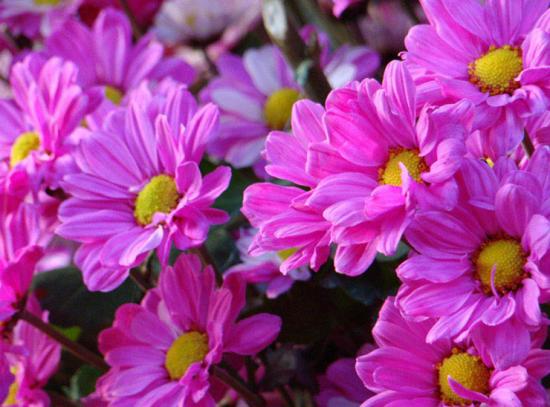
The following pests are dangerous for chamomile chrysanthemums:
- aphid
- snails
- slugs
- worms
To protect the chrysanthemum from fungal diseases, the plant is sprayed with antifungicides at the beginning of summer. If infection has already occurred, then the affected areas are cut off and destroyed. Water the chrysanthemum with settled warm water. The earthen clod must not be allowed to dry out.
In the cool season, the intensity of watering decreases. And in the winter, the soil is only slightly wetted. These plants do not make great demands on the composition soil, but exhibit increased susceptibility to light conditions.
Transplant methods
In late autumn, after flowering has ended, the plant is trimmed with garden shears near the ground and stored in cellars with an air temperature of 3-5 C. Planting in the ground is carried out in March. The flower pot is placed in a room with a temperature of 15-18C. To plant chrysanthemums, use soil containing:
- Rotted manure
- Peat substance
- Sod land
- river sand
After 2 weeks, the first feeding is carried out.After the weather settles and frosts are not expected, the pot with the chrysanthemum is removed from the room. As the stems grow, the ends are pinched to allow side shoots to grow.
Video about the necessary care for chamomile chrysanthemum:
Reproduction
The plant can be propagated using seeds or cuttings. Seeds are sown in one pot, and as they germinate, they are transplanted into individual containers. The soil used for planting is loose and rich in nutrients. Cuttings are made from strong young shoots. The cut is made with pruning shears under the leaf node. Each cutting is planted in a separate pot with a diameter of up to 9 cm.
The soil is used from a peat humus mixture, and sprinkled with a two-centimeter layer of sand on top. Sometimes only sand substance is used for rooting. In pots with such soil, the plant germinates for 3 weeks, and after that it is planted in containers with a large volume. After roots appear on the cuttings, the plant is fed with flower complexes. fertilizers.
Benefits and applications in cooking and traditional medicine
Some varieties of chrysanthemums that have white or yellow flowers are suitable for making tea, which has medicinal properties for treating colds. The leaves of some of them are suitable for salads, as well as for cooking with vegetables with the addition of garlic, salt and pepper.
Eating such flowers drives out parasites. Remember that chrysanthemum is dangerous, for example, for aquarium fish. In Chinese medicine, chrysanthemums are used for medicinal purposes. The leaves are used to treat migraines, and the dried flowers are prescribed to stabilize appetite.
Medicine in other countries uses this flower to treat malaria, alcoholism and eye diseases. As a preventive measure, chrysanthemum is used against stomach diseases and heart failure. Eastern healers believe that youth helps to keep a bouquet of chrysanthemums next to the bed. This is explained by the presence of vitamins and essential oils in flower petals, which have a beneficial effect on human health.
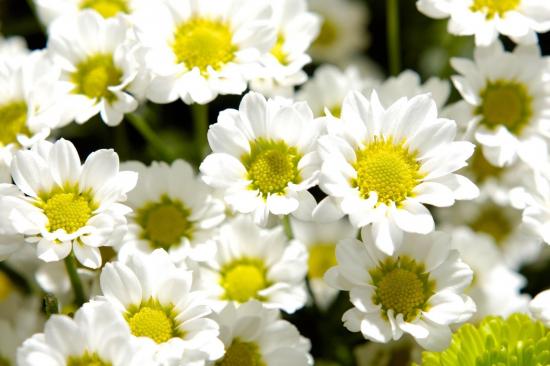
It is recommended to take warm baths with an infusion or decoction of chrysanthemum flowers in the autumn. To do this, the petals of one chrysanthemum are brewed with 500 ml of boiling water and allowed to brew for 15 minutes. This procedure is done every 1-2 days for two weeks. To treat eczema, diathesis, neurodermatitis, add the juice of 1 lemon to a bath with chrysanthemum infusion. The procedure is carried out every other day for 10 minutes.
Painful symptoms in joints arising from arthritis, arthrosis or rheumatism are eliminated with compresses from petals chrysanthemums soaked in vegetable oil. Osteochondrosis is treated by rubbing chrysanthemum infusion. Knowing the peculiarities of growing chrysanthemums - chamomile, these flowers will delight you on your garden plot or terrace until the cold weather and will help you cope with diseases.

